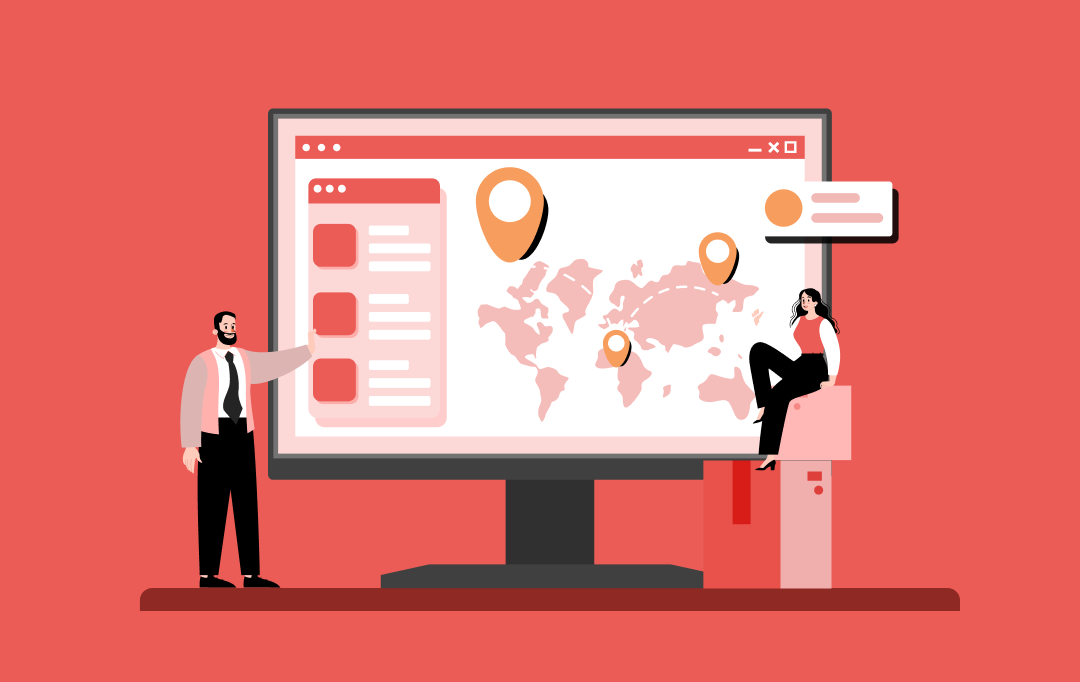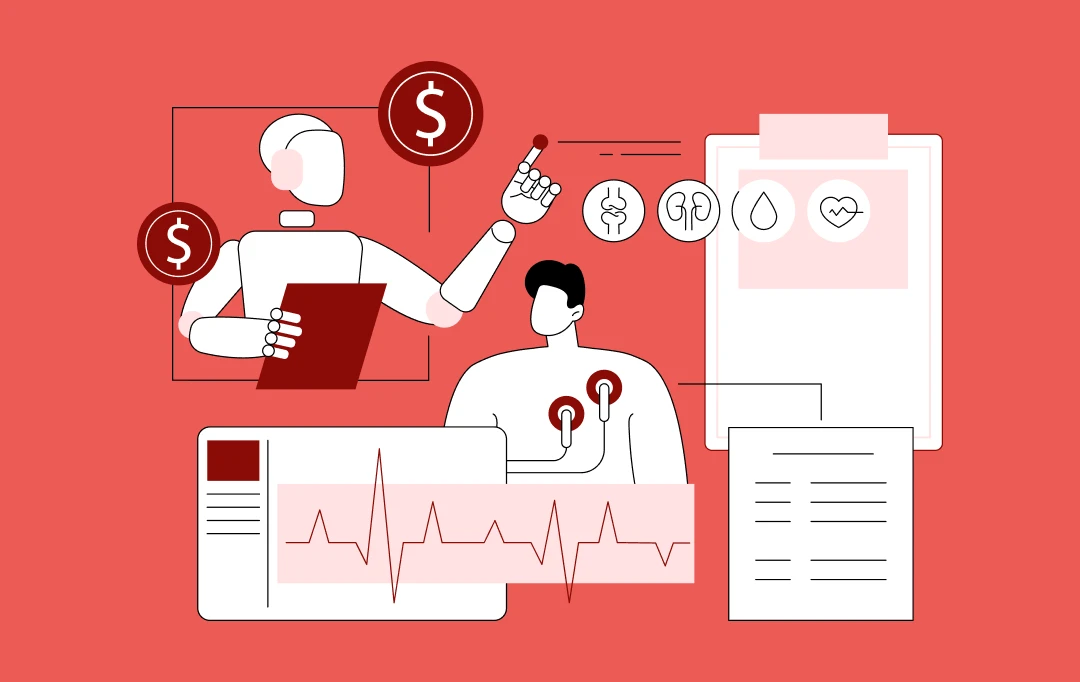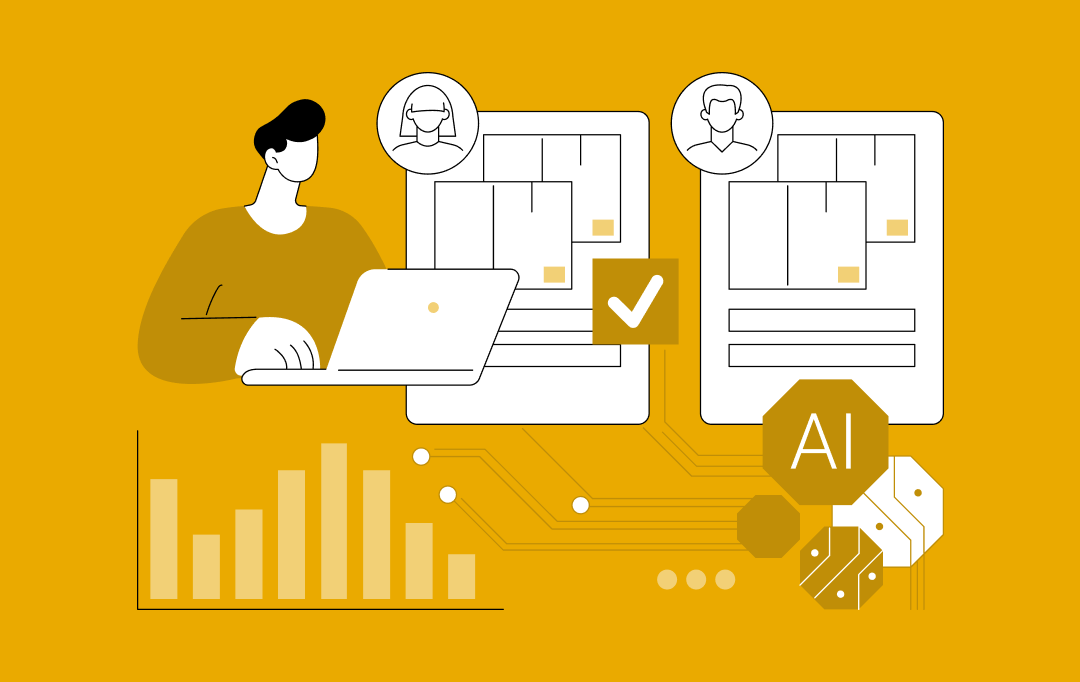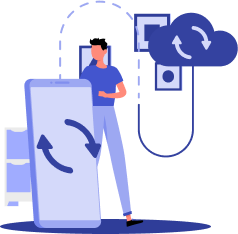- Mapping Emerging Technologies to Enterprise Use Cases
- How Each Technology Aligns with Core Business Domains
- Challenges and Risks in Enterprise Technology Integration
- Legacy Systems and Coexistence Strategies
- Data Silos, Quality, and Semantic Interoperability
- Security, Privacy, and Governance with New Tech
- Skills, Culture, and Organizational Resistance
- Performance, Scalability, and Technical Debt
- A Strategic Framework & Roadmap for Integration
- Assess & Prioritize Use Cases
- Define Target Architecture & Integration Vision
- Build a Unified API / Data Fabric Layer
- Agile, Incremental, Pilot Then Scale
- Governance, Compliance & Risk Controls
- Change Management, Training & Adoption
- Monitoring, Feedback & Continuous Optimization
- Types of Technology Integration in Modern Enterprises
- Enterprise Integration Platforms and Technologies
- Integration Patterns, Best Practices & Design Principles
- Real-World Enterprise Integration Case Studies
- AI / ML + Legacy CRM / ERP Integration
- IoT / Digital Twin in Operations Workflow
- Agentic AI Orchestrating Multi-System Tasks
- Blockchain for Secure and Transparent Transactions
- Measuring Success: Metrics, ROI & Business Value
- Technical and Integration KPIs
- Business KPIs
- Adoption and Qualitative Metrics
- Time Horizon and ROI Phases
- Future Trends in Enterprise Technology Integration
- AI-Native Integration Fabrics and Agentic Workflows
- Composable and Mosaic Architectures with XaaS Models
- Federated Learning, Zero-Trust Integration, and Edge AI
- Why Partner with Appinventiv for Enterprise Integration
- FAQs
Key Takeaways
- Big changes fail when rushed. Begin with small pilots, measure results, and use emerging tech to scale without breaking what works today.
- Clean, connected data and strong security are the backbone of successful technology integration. Get those right before layering on AI, IoT, or automation.
- Don’t chase every new tool. Match tech to business goals, train teams early, and expand only after proving value in controlled rollouts.
- Avoid “rip and replace.” Blend old and new systems with APIs and modular design to reduce risk, cost, and downtime.
- Long-term ROI comes from ongoing care — monitor performance, gather user feedback, and refine integrations to avoid technical debt and wasted investment.
Big companies tend to run on older systems. They’re dependable, but they don’t adapt easily. Meanwhile, new tech keeps showing up — AI, IoT, low-code tools — all promising speed and smarter decisions. The tricky part is making those promises work without breaking the setup you already rely on.
That’s what technology integration really is: fitting new capabilities into the day-to-day so people can keep working and data keeps moving. Successful tech adoption also means balancing speed with stability, so change doesn’t disrupt critical operations. When you take time to plan it well, the business becomes quicker and more flexible. When you don’t, you end up with extra complexity, stalled projects, and money wasted on tools no one fully uses.
If you’re running an enterprise today, figuring out how to bring emerging technologies into the fold safely isn’t just nice to have. It’s how you keep up.
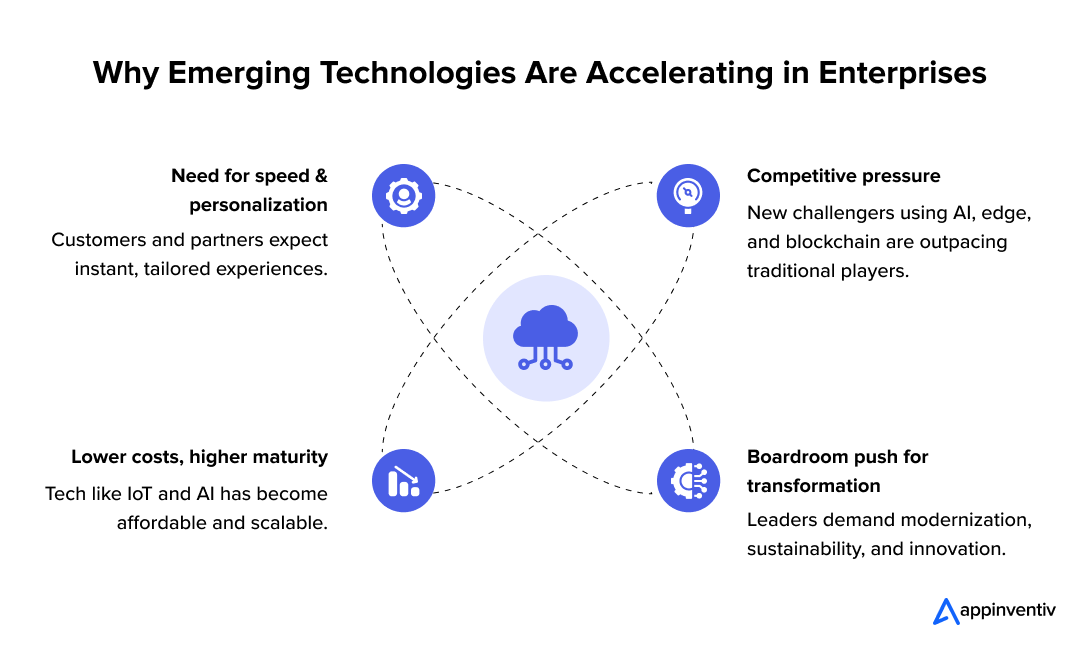
Gartner expects that by 2028, one-third of enterprise software applications will include agentic AI, up from nearly zero in 2024. However, Gartner also warns that over 40% of agentic AI projects may be canceled by 2027 due to cost, complexity, or unclear value.
The implication is clear: success isn’t in chasing shiny tech — it’s in smartly driving enterprise technology integration so new systems work with what’s already there. That also means being deliberate about adapting emerging technologies, not just experimenting with them.
Mapping Emerging Technologies to Enterprise Use Cases
For many enterprises, the hardest part of digital transformation is deciding where to start with emerging technologies in business. The tech world moves fast and can feel noisy. Every week brings a new buzzword or “must-have” platform. Without a clear way to sort what’s practical from what’s hype, teams risk chasing trends and ending up with pilots that don’t scale or connect to business goals.
Having a simple map of emerging technologies makes it easier to see what’s worth attention and how it can fit into the systems you already rely on. This step lays the groundwork for long-term enterprise technology integration instead of quick, disconnected experiments.
Taxonomy of Emerging Technologies
Seeing the big picture matters more than trying to master every new tool. Grouping emerging technologies in business into clear categories helps leaders and technical teams decide where to experiment and where to double down.
AI / ML and Agentic AI
Artificial intelligence has gone from a side experiment to something most enterprises can’t ignore. Predictive analytics helps with demand planning and risk spotting, while machine learning makes recommendations and automates decisions. The newest shift — agentic AI — moves beyond suggestions. These software “agents” can plan and act across systems. Think of an AI that reviews ERP data, updates inventory, and triggers CRM workflows without needing human hands on every step.
IoT, Edge and Digital Twins
Machines, vehicles and even retail spaces now throw off a constant stream of data. Small sensors track heat, pressure, movement — whatever matters to the work. Processing some of that data right where it’s created keeps things fast and less expensive. When companies build a digital twin — a virtual copy of a machine or warehouse — they can test “what if” scenarios, catch problems early and plan maintenance before anything breaks.
Blockchain and Distributed Ledger
When most people think of blockchain, they picture cryptocurrency. But inside enterprises, it’s proving to be a simple and reliable way to keep records clean and traceable. It lets companies track transactions, assets, or data movement with complete transparency. Once something is recorded, it stays there, which makes it easier to build trust with partners, customers, and regulators.
It also takes away a lot of the manual checking and paperwork that slows teams down. With the right consulting support, businesses can use blockchain to make information sharing faster, safer, and more verifiable — turning it from a buzzword into a real operational advantage.
AR, VR and Spatial Computing
Augmented reality adds helpful information to the real world. A field engineer can see live diagnostics while standing in front of a machine. Virtual reality creates safe spaces to train teams or test designs before production. Combined with spatial computing, these tools let people move between digital and physical work more naturally.
How Each Technology Aligns with Core Business Domains
Understanding how each innovation supports core functions gives decision-makers a clearer map. Integrating new technologies into enterprises isn’t just about tools; it’s about matching each one to supply chains, customer experience, operations, and R&D in ways that create measurable impact. For example, AI/ML can detect anomalies in logistics early. Digital twins can mirror factory assets. Integration fabrics ensure that AI outputs feed directly into enterprise CRM systems and operations, ensuring data-driven actions across the business.
| Business Domain | Relevant Emerging Technologies | Role / Use Cases |
|---|---|---|
| Supply chain & logistics | IoT / Edge, digital twins, blockchain, AI | Real-time tracking, predictive maintenance, provenance & ERP integration. |
| Customer engagement & CX | AI / generative models, AR/VR, integration fabrics | Personalization, immersive experiences, omnichannel flows |
| Operations & process automation | AI agents, low-code integration, IoT | Cross-system automation, orchestration, real-time dashboards |
| R&D / simulation & modeling | Digital twins, AI/ML, AR/VR | Scenario planning, virtual prototyping, “what-if” simulation |
This simple alignment table helps teams spot where to begin and plan small, controlled rollouts. Calling out the benefits of effective technology adoption here also makes it clear why aligning tech with core domains saves cost and reduces risk.
Challenges and Risks in Enterprise Technology Integration
Bringing new technology into an enterprise is never just about tools. Effective digital integration is a careful balance: protecting the systems that keep the business alive while making room for what’s next. The problems below come-up again and again, but each one can be solved with the right approach and patience. Careful planning around new technology implementation helps avoid these common pitfalls and keeps change manageable.
Legacy Systems and Coexistence Strategies
A lot of core business software runs on code written years ago. It still does its job, but it’s fragile and hard to replace. Pulling it out all at once can stop critical processes and burn through time and money. A safer way forward is to let the old and new IT systems integrate side by side until the transition is ready.
- Use modern APIs. Wrap older programs so they can talk to new ones without tearing everything apart right away.
- Move in small steps. Shift features one by one into newer, modular services and turn off the old pieces gradually.
- Bridge the gap with integration tools. Use platforms that can translate between outdated protocols and current systems until the full change is ready.
- Stabilize what you already have. Put older apps into containers so they’re easier to run, scale, and manage while you work on long-term replacements.
Data Silos, Quality, and Semantic Interoperability
Emerging tech depends on clean, connected data integration— but many enterprises have the opposite: fragmented stores, conflicting formats, and no shared meaning. Without fixing this, AI models fail and analytics mislead.
- A data fabric or data mesh can unify access to scattered data while letting it stay where it is.
- Shared vocabularies and semantic models give systems a common language for customers, products, and transactions.
- Streaming tools like Kafka bring real-time IoT or transactional data into one place.
- Data quality platforms and lineage tracking help teams trust what’s coming out of these pipelines.
Security, Privacy, and Governance with New Tech
Every new connection creates a new door. AI models can leak training data, IoT devices can be hijacked, and blockchain records last forever — mistakes included. Security has to scale along with innovation.
- Strengthen your enterprise application security by adopting zero trust principles — ensuring every connection proves its identity before access.
- Don’t assume anything inside is safe by default. Make every system prove who it is before you let it in.
- Encrypt your data, always. Protect it while it’s moving and while it’s stored.
- Keep an eye on AI models. Watch for odd or unexpected outputs so you can catch issues early.
- Secure IoT devices from day one. Use certificates, keep them patched, and put them on separate networks so a breach can’t spread.
- Be careful with blockchain. Use permissioned networks and check smart contracts thoroughly before they go live.
Skills, Culture, and Organizational Resistance
Technology projects fail as often because of people as because of code. Employees worry about change or lack the know-how to run new systems. Integration succeeds faster when the organization is brought along early.
- Form integration Centers of Excellence to set standards and share best practices across teams.
- Train staff on APIs, containers, cloud-native development, and MLOps so they can support and extend new systems.
- Name change champions to advocate, answer questions, and build trust.
- Tie every integration initiative to clear business outcomes to get leadership buy-in.
Performance, Scalability, and Technical Debt
New tools can slow down existing ones if scaling isn’t planned from the start. Performance dips, outages, or fragile connections can build a hidden cost over time. In fact, research shows 95% of generative AI projects don’t impact profit and loss because integration — not the AI itself, is flawed.
- Use event-driven design so systems can talk without waiting on each other and avoid tight coupling.
- Think ahead about growth. Don’t wait until systems slow down under load. Build so you can add servers or capacity easily when traffic spikes.
- Keep an eye on the system while it runs. Use tools that show what’s happening in real time so you spot slowdowns or bottlenecks before anyone complains.
- Be careful when changing APIs. When something needs to update, make sure older connections still work and test it so nothing breaks for the teams relying on it.
- Track what you’ve built, keep a visible list of connectors and dependencies so you can replace or clean up older pieces before they cause big technical debt. This proactive cleanup is also a key step toward enterprise technology sustainability, keeping systems reliable and cost-effective long term.
A Strategic Framework & Roadmap for Integration
Big changes work best when they are broken down into steps. Instead of trying to plug emerging technologies in business everywhere at once, map out where it matters most, get a few quick wins, and expand from there. This keeps risk low and builds trust across the company. Clear steps to successfully implement new technology in the existing workflows ensure teams know what to expect and how to adapt along the way.
Assess & Prioritize Use Cases
Start by looking for everyday friction — slow approvals, duplicate data entry, or manual reports that take hours to compile. These pain points show where new tools will pay off quickly. Rank them by impact, cost, and how easily they fit with your long-term plans. Focusing here gives you early proof that integration is worth the effort. Early wins also build confidence across teams and highlight the advantages of early technology adoption, making adopting new technology in business feel practical instead of risky.
Define Target Architecture & Integration Vision
Next, picture how the pieces should connect once the new tech is in place. Use APIs wherever possible so systems can plug in without custom work. Prefer events and messages to one-off links that break easily when something changes. Make sure data is not locked in one team’s system but is still governed and secure. Clear architecture diagrams also guide teams when implementing and testing the new technology so that every new connection can be validated safely before scaling.
Build a Unified API / Data Fabric Layer
Create a backbone that lets everything communicate. Integration platforms or service buses can handle translation and security so developers do not have to keep reinventing connections. Using enterprise application integration technologies at this stage ensures those connections are scalable, secure, and easier to maintain as the system grows. A well-designed data fabric helps give applications and analytics one reliable view of information, no matter where it lives.
Agile, Incremental, Pilot Then Scale
Do one thing well before you do many. Choose a single process or department, run a small pilot, measure the impact, and refine the approach. Then repeat. Each win builds confidence and lessons you can use for the next rollout — a practical way of implementing and testing the new technology before scaling across the enterprise.
Governance, Compliance & Risk Controls
Keep risk and compliance in the room from the start. Decide who owns which data, how it is protected, and how you will monitor AI models or new platforms. Review vendors carefully so you do not run into legal or security surprises later.
Change Management, Training & Adoption
Technology does not change a business if people do not use it. Many challenges in integrating emerging technologies in enterprises arise when teams are left uncertain or unsupported during change.
Introducing new technology into the workplace can unsettle teams if it’s not explained and supported properly. Talk openly about what is coming and why. Train teams early and show them what gets easier once the new system is running. Pick a few respected champions who can answer questions and build enthusiasm.
Monitoring, Feedback & Continuous Optimization
Over time, you will spot patterns to improve each rollout. Integrating new technologies into enterprises becomes easier when feedback loops stay active and teams refine how systems interact after launch.
Explore our technology integration services to see how we make complex systems work seamlessly.
Types of Technology Integration in Modern Enterprises
Before you decide how to connect everything, it’s worth stepping back and naming the kinds of connections businesses usually need. Each one solves a different problem. Knowing the difference saves time and rework later.
- Application Integration: Most teams end up using a mix of tools that don’t talk to each other. Application integration closes those gaps. Data and processes can move in real time, so people stop copying the same numbers between systems.
- Data Integration: Information lives in too many places — spreadsheets, old databases, cloud tools. Data integration pulls it together into one clear picture. That’s what makes analytics and AI work instead of guesswork.
- Cloud Integration: Many companies run partly on the cloud and partly on old on-prem servers. Cloud integration ties those worlds together so files, apps, and workflows move without breaking security or slowing things down.
- API Integration: APIs are the connectors between apps. Linking them well means updates in one place show up everywhere they should — no manual syncing or duplicate effort.
- Platform Integration: Instead of building one-off connections, some teams use integration platforms (iPaaS). They give you a safer, faster way to hook up apps and data as the business grows.
- Process Integration: This isn’t about one app talking to another; it’s about making whole workflows run smoothly across departments. Less manual back and forth, fewer delays, and fewer missed steps.
- Device Integration: For IoT and equipment-heavy industries, device integration gets machines and sensors to feed data where it’s needed — for monitoring, automation, or predictive fixes before something breaks.
Getting these basics straight makes later choices easier. Once you know which kind of integration you need most, picking patterns and planning rollouts becomes a lot clearer.
Enterprise Integration Platforms and Technologies
For a company to feel connected end to end, the systems behind it have to talk to each other. The apps your teams use, the data running between them, the devices streaming updates — they all need to work as one. Most businesses have a mix of old and new tech. Stitching it together is not easy, and that is where enterprise integration platforms and technologies step in. They are practical tools for making new and existing systems work as a whole.
- iPaaS (Integration Platform as a Service)
A cloud service that links apps and data across whatever setup you have: cloud to cloud, cloud to on-prem, even partner networks. It cuts down on custom coding. - Messaging
A simple way for software parts to pass information back and forth, even if they are built in different languages or on different platforms. - Pub/Sub (Publish/Subscribe)
One system shouts “something changed,” and any other system that cares listens and acts. It is flexible and keeps things from being tightly tied together. - Application Connectors
Prebuilt connectors that save time. Instead of wiring each new tool from scratch, you can plug it in and start moving data quickly. - Data Streams
Continuous flows of live data that can feed dashboards, analytics, or monitoring tools. Great for IoT and anything that depends on real-time insight. - Enterprise Integration Patterns (EIPs)
Common playbooks for known problems: how to route messages, manage errors, or change data formats. They help teams avoid reinventing the wheel. - APIs (Application Programming Interfaces)
APIs let different systems talk without knowing the details of each other’s design. They are the backbone of modern integration work.
There is no single right mix. Most companies use a few of these approaches at once, starting small and adding more as needs grow.
Integration Patterns, Best Practices & Design Principles
How systems connect can make or break an integration project. Well-chosen patterns keep things flexible and reliable. Poor ones lead to tangled dependencies and painful rewrites. Modern enterprise application integration technologies give teams proven ways to link systems without creating fragile, one-off connections. Here are the building blocks most enterprise teams rely on, explained simply.
API-Led Connectivity vs Message or Event-Driven Patterns
With an API-led approach, one system asks another to do something and waits for an answer. It is simple and great for direct actions like “get customer details” or “update order status.”
In an event-driven setup, a system announces that something happened, for example, “order created,” and other systems decide what to do with that information. Nobody waits for a reply. This keeps everything more independent and lets different parts scale without affecting each other.
A good rule of thumb: APIs work best when you need a quick response, while events are ideal when many things need to react to the same change.
Orchestration vs Choreography
When several services work together, you can either have a traffic controller or let each service figure out its own moves.
- Orchestration means one central system knows the full plan and calls each step in order. It is easier to monitor but creates a single control point.
- Choreography is looser. Each service reacts to events and triggers the next step. It is more flexible but requires careful design to avoid confusion.
Many companies start with orchestration for clarity and then move to choreography as their systems and teams mature.
Modular, Plug-In, and Decoupled Architecture
Treat your systems like Lego pieces. Each part should be replaceable or upgradeable without breaking the whole build. This modular approach avoids the “big ball of code” problem where every change is risky. Connecting modules through APIs or events makes adding new technology far easier later.
Versioning, Backward Compatibility and Rollback
Systems evolve. When you change an API or a data model, keep the old version working for a while so teams can adjust. Plan for rollbacks if a release causes trouble. Many teams use feature flags to test new functions safely with a small group before rolling them out company-wide.
Edge, Federated and Hybrid Integration
Not everything needs to run in the cloud or data center. In IoT or time-sensitive use cases, it can help to process data where it is created such as on the shop floor, in a vehicle, or inside a device. This keeps things fast and reliable even if connectivity drops. Later, the results sync back to core systems. A mix of local and central processing often gives the best balance of speed and control.
Real-World Enterprise Integration Case Studies
Real-world success stories make integration lessons tangible. These technology implementation examples show how different organizations handled legacy barriers, scaled safely, and proved ROI. They show how organizations overcame legacy barriers, handled scale, and proved ROI. The following examples highlight how different technologies have been embedded into enterprise systems and the impact they created.
AI / ML + Legacy CRM / ERP Integration
In a study of integrating AI into ERP, enterprises saw ~30% gains in productivity and ~25–30% uplift in user satisfaction when personalization and predictive analytics were embedded. ResearchGate
One concrete example is from Wipfli’s work with mid-market businesses, where AI models are connected to ERP and CRM systems so that insights combine operational and customer data. This kind of integration aligns both sides of the business, turning AI outputs into actionable and context-aware decisions.
IoT / Digital Twin in Operations Workflow
Modern operations rely on live data instead of fixed schedules. Small IoT sensors inside machines track temperature, vibration, and wear as work happens. The data builds digital twins, virtual models of the real equipment, so teams can see performance in real time. They can test scenarios, plan maintenance before something breaks, and solve problems early. When a digital twin finds an issue, it can trigger a work order or alert the right team, cutting downtime and keeping production steady.
Appinventiv used the same idea while building the Ility Real Estate SaaS Platform. IoT-powered smart locks and other access devices were linked to a single platform, creating a real time view of how buildings operate. Data moves securely through APIs, giving property managers clear insight and letting them act quickly when something needs attention. This use of IoT data to predict and prevent issues follows the same principle that makes digital twins valuable in industrial operations.
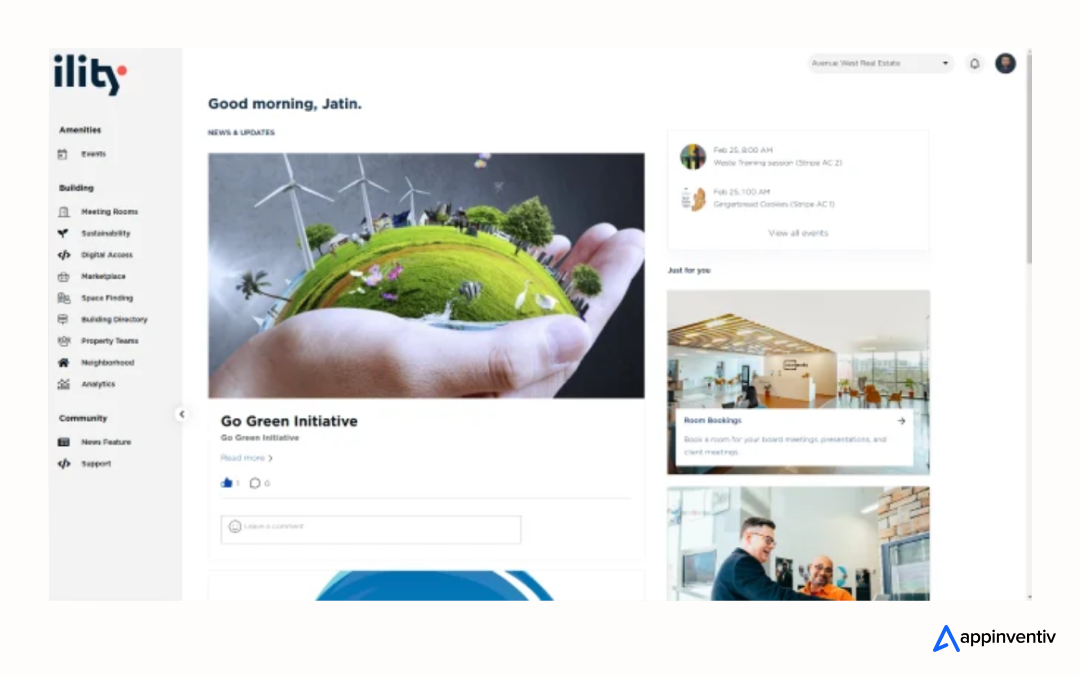
Agentic AI Orchestrating Multi-System Tasks
AI is starting to do more than just give advice. Many companies now use autonomous software agents that can step in and act on their own. Instead of only pointing out low stock, an agent can place a purchase order, update the ERP system, and alert suppliers without waiting for a person to approve it. Early adopters say this speeds up everyday work and reduces mistakes. To keep things safe, teams set clear rules, control what agents can access, and watch their output closely. Analysts expect that by 2028, about one third of enterprise applications will use this kind of intelligence.
A strong example is the MyExec AI Business Consultant. Appinventiv built it to work like a smart business partner rather than a simple chatbot. It reviews documents, links into internal systems through APIs, and turns complex information into clear actions for decision-makers. This approach shows how agentic AI can combine reasoning, integration, and action to create meaningful results for an enterprise.
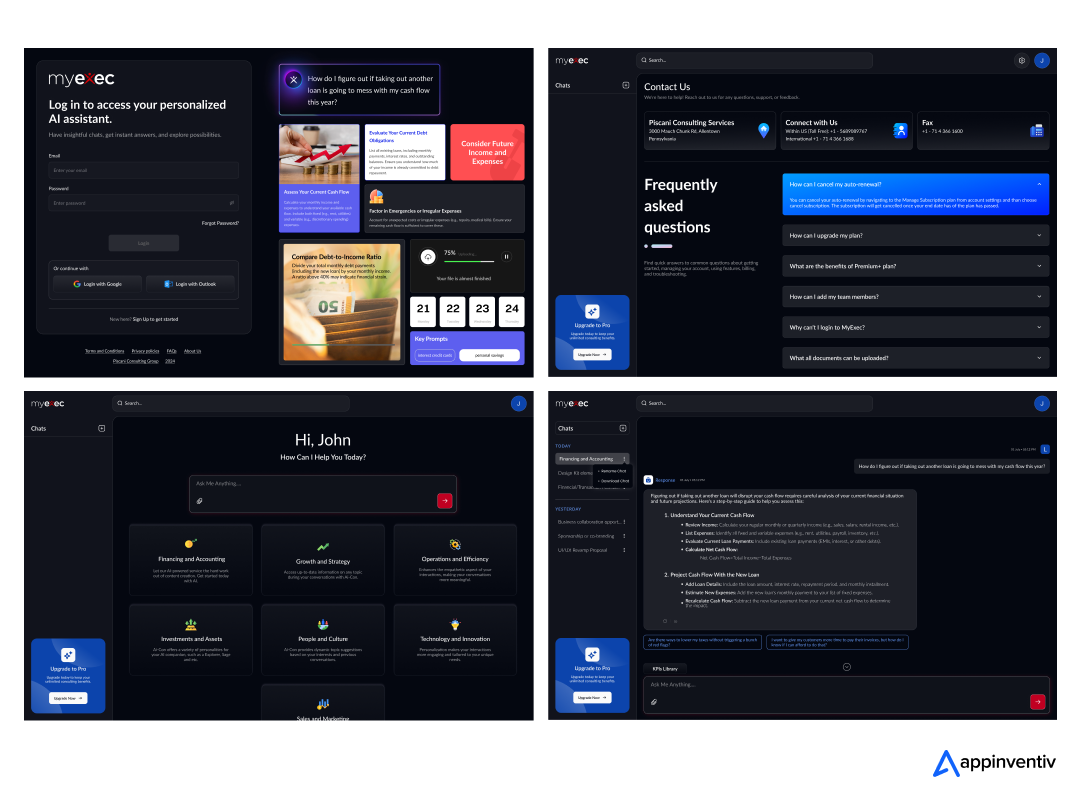
Blockchain for Secure and Transparent Transactions
In travel and hospitality, trust is everything. Appinventiv tackled this head-on when building the Empire Hotel Booking App, using blockchain to keep bookings and payments safe and clear. Each transaction goes into a secure ledger and cannot be changed once it is written.
This setup cuts out hidden middle layers and helps prevent fraud or double bookings. It also gives hotels and guests a record they can trust. Because the blockchain is tied directly into back-office and compliance systems through APIs, booking and payment details flow straight into operations and finance without extra manual checks or delays.
Measuring Success: Metrics, ROI & Business Value
Turning a new system on doesn’t mean the job is done. The real proof comes after the rollout — when you watch how the technology behaves under real pressure and whether it’s actually helping the business. Measuring impact is critical because introducing new technology into the workplace can look successful at first but fail quietly if it isn’t tracked and refined. Tracking clear, shared metrics early also makes it easier to show progress and get buy-in for the next phase.
Technical and Integration KPIs
Start with the basics. These numbers tell you if the new and old systems are working well together.
- Latency and response time — how quickly one system replies when another calls it. If it’s slow, teams will feel it right away.
- Throughput — how much traffic the setup can handle before it struggles.
- Error rates — how often things break or calls fail. Each error usually means someone has to step in manually.
- Uptime — how often the connected systems stay online and available.
- Model drift — if you’re using AI, check whether predictions or outputs start slipping over time.
Business KPIs
Technical success means little if the business does not see impact. Focus on results that matter to leadership:
- Cost savings or avoidance — less duplication, fewer manual tasks, and reduced downtime.
- Time to market — faster release of new products or features.
- Productivity lift — whether teams spend less time switching between systems or waiting for data.
- Process cycle time — how long key workflows take now compared to before.
- Revenue or margin improvement — better forecasting, smarter pricing, and more upsell opportunities.
Adoption and Qualitative Metrics
People need to embrace the new systems for success to last:
- User satisfaction and NPS — ask how easy the new experience is and how likely teams are to recommend it.
- Adoption rate — the share of teams or processes actively using the new tools.
- Developer experience — how easy it is for internal teams to maintain and extend integrations.
- Feedback and sentiment — regular check-ins and support tickets reveal friction points early.
Time Horizon and ROI Phases
Expect payback in stages, not overnight:
- Short term — pilots bring quick wins like fewer manual steps and faster reporting.
- Mid term — as more systems connect, cost savings and process speed increase.
- Long term — the biggest impact comes once data flows freely and AI-driven decisions reshape how work gets done.
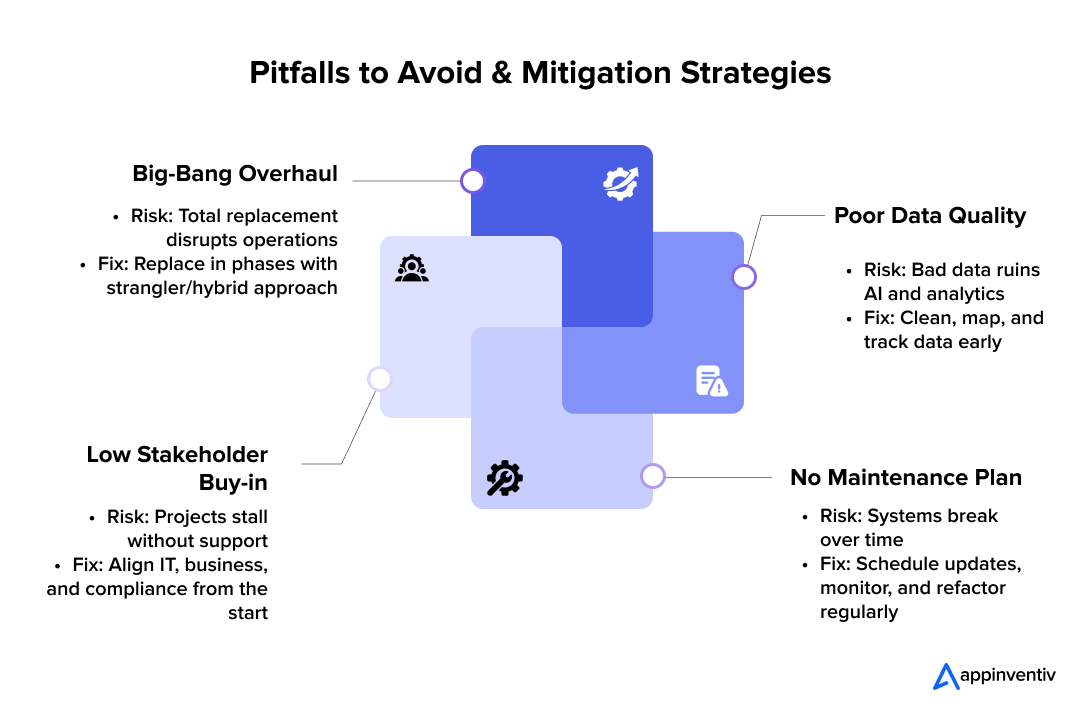
Future Trends in Enterprise Technology Integration
Enterprise technology integration will not stand still. The way systems connect is shifting quickly as enterprises demand faster adaptation, stronger security, and more intelligence at every layer. Recognizing the benefits of effective digital transformation upfront helps leaders adapt to these shifts with confidence and measurable outcomes. Below mentioned are a few trends that show where integration strategy is heading next, underscoring the advantages of early technology adoption and how emerging technologies in business will continue to reshape enterprise systems.
AI-Native Integration Fabrics and Agentic Workflows
Future platforms will have AI built directly into their integration backbone. Instead of adding AI tools on top, enterprises will adopt AI-native integration fabrics where APIs, data flows, and orchestration are adaptive and self-optimizing. Analysts predict that by 2028, one-third of enterprise applications will include agentic AI to automate multi-system workflows and reduce manual oversight.
Composable and Mosaic Architectures with XaaS Models
Integration is moving away from single, tightly coupled platforms toward composable architectures. Businesses will combine microservices and packaged business capabilities like mosaic tiles, adding or swapping functions without breaking the whole system. “Everything as a Service” (XaaS) will make it easier to subscribe to ready-made capabilities and plug them in quickly.
Federated Learning, Zero-Trust Integration, and Edge AI
Data privacy, latency, and autonomy are pushing architectures outward toward the edge. Federated learning allows models to train locally across distributed data sources without pooling sensitive data in a central system. Meanwhile, zero-trust integration models ensure that every connection, even between internal services, must authenticate and authorize access. Edge AI — executing inference close to where data is generated — is becoming essential in use cases needing instant response, especially when connectivity is intermittent.
Why Partner with Appinventiv for Enterprise Integration
Successful technology integration isn’t just about plugging in a tool. It means working with what you already have, keeping critical systems running, and making sure new investments deliver real business results. That’s where Appinventiv comes in, guiding every step of the technology implementation process so enterprises can adapt safely and effectively.
We have spent years helping large organizations bridge the gap between old and new through smart use of technology. Our teams know how to work with legacy systems, protect sensitive data, and design architectures that can scale as the business grows. Because we offer true digital transformation services, we stay with you from the first strategy conversation to design, build, and long-term support.
More importantly, we focus on outcomes, not just implementation. Our work has helped enterprises launch AI-powered automation, connect IoT devices to existing operations, and make data easier to use across teams — without unnecessary risk or downtime. For instance, our AI-driven banking solution helped a leading European bank automate key processes and improve customer experience. We’ve also guided retailers such as IKEA in creating modern shopping apps that support digital transformation.
If you are exploring emerging technologies in business or want to modernize existing systems safely, we can help you move forward with confidence. Whether it’s an architecture review, a pilot project, or a full integration plan, Appinventiv can guide your transformation and make it work for the business, not against it. Our approach also focuses on enterprise technology sustainability, ensuring every integration decision supports long-term stability and growth instead of short-term fixes.
Need a safer way to bring AI, IoT, and other tools into your core systems? Talk to our integration experts.
FAQs
Q. What are the biggest challenges in integrating emerging technologies in enterprises?
A. A lot of companies hit the same roadblocks, old systems that don’t connect well with new tools, scattered data that’s hard to trust, and security concerns when you open new connections. On top of that, people worry about change and whether they’ll be able to work with new systems. Careful technology integration done slowly, with clean data and early involvement of security and IT teams helps avoid messy surprises.
Q. How to implement new technology in the workplace without disrupting daily operations?
A. Start small and safe. Pick one process or department to test the change before going all in. Train the people who’ll use it, explain why it matters, and make sure there’s support if things break. Think of it as a loop — try, measure, adjust, expand — instead of one huge launch.
Q. How can enterprises adapt to emerging technologies while maintaining stability?
A. Don’t jump on every new buzzword. Focus on the business outcomes you need first, then look at which tech can actually help. Build flexible links so changes don’t break what’s already running. And talk to teams early; when people know what’s coming and get a chance to learn, the shift feels safer.
Q. What is the recommended technology implementation process for large enterprises?
A. Spot the pain points that matter most, like slow manual work or duplicate systems. Plan how the new tools will plug in, make sure your data and security are ready, and run a pilot to see how it performs. Fix what you learn from that test, then scale it gradually across the company.
Q. How can you measure the success of new technology implementation?
A. Don’t just look at system dashboards — ask people how it’s going. Check if things are faster and more reliable: fewer errors, better uptime, quicker response times. See if teams save hours or can launch features faster. Track costs and revenue impact too. Combining the human feedback with the hard numbers gives you the real story.


- In just 2 mins you will get a response
- Your idea is 100% protected by our Non Disclosure Agreement.

How To Build a Digital Twin App? All You Need To Know
Key takeaways: IoT, AI, cloud computing, and data analytics are the main technologies for making real-time, predictive digital twins. Digital twins are revolutionizing the manufacturing, healthcare, and energy sectors and providing significant operational efficiency and cost reduction. 5G, edge computing, and AR/VR not only lift digital twin performance but also provide fast data processing and…

Digital Transformation Strategies You’ll Wish You Knew Sooner
Key takeaways: Think Big, Not Small: Digital transformation market will reach USD 3,289.4 billion by 2030. Update Legacy Tech: Outdated systems? Modernize them now to boost efficiency and save costs. Go Cloud and API First: Focus on flexible, scalable cloud solutions and APIs for faster, more efficient operations. Make Tech Work for Business: Your tech…

Digital Transformation Strategy for Australian Enterprises: A Practical Roadmap
Key takeaways: Australian businesses must embrace digital change to remain competitive in today’s market. Successful digital transformation requires a focus on people, processes, and technology. Overcoming resistance to change and outdated systems needs a clear strategy and the right partners. Industry case studies show that effective digital transformation delivers real business value and strong ROI.…











